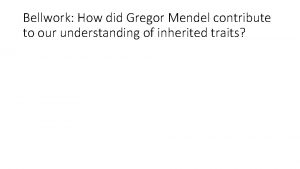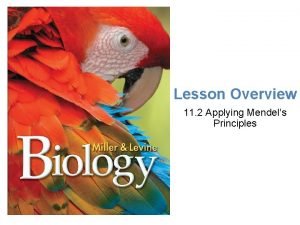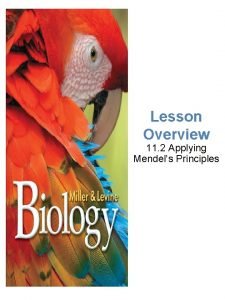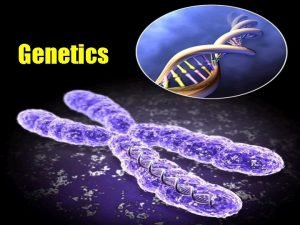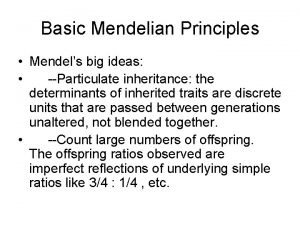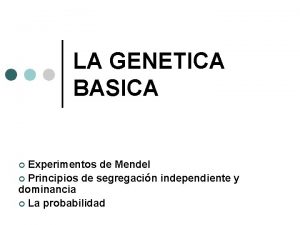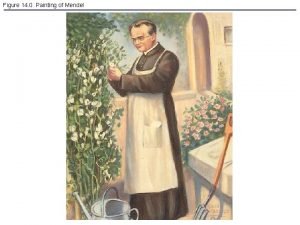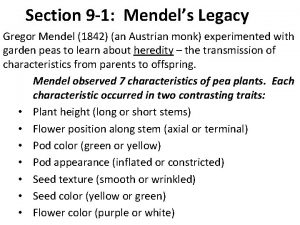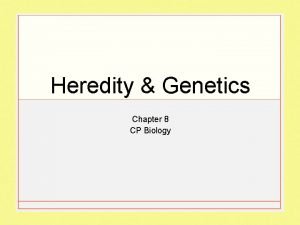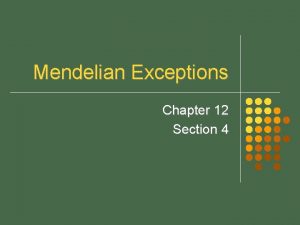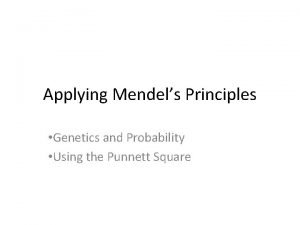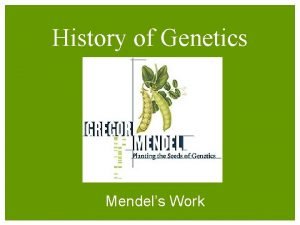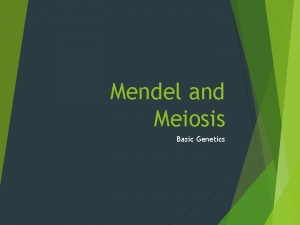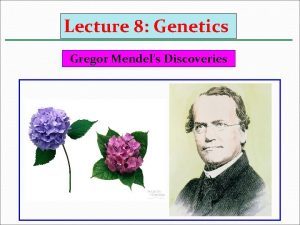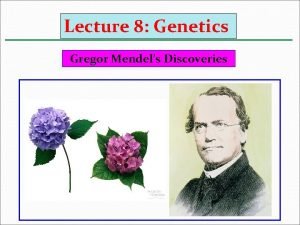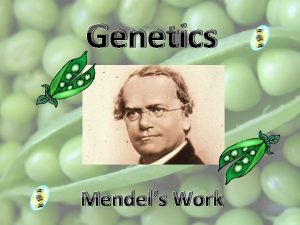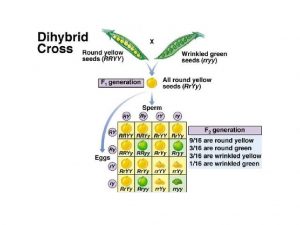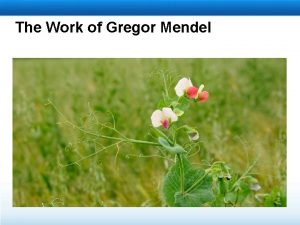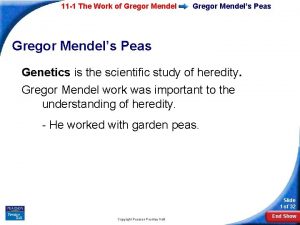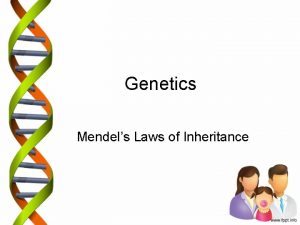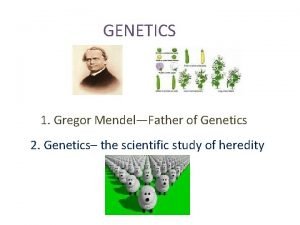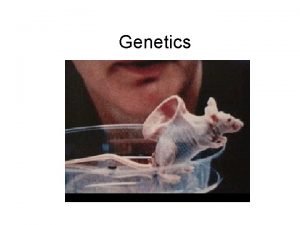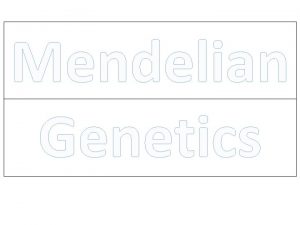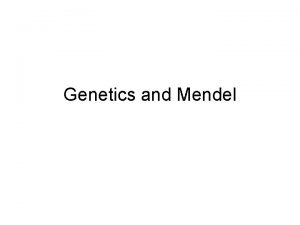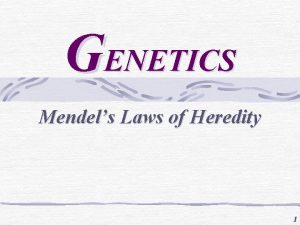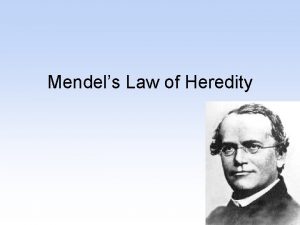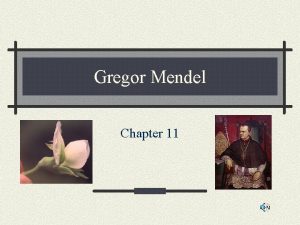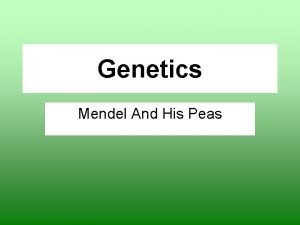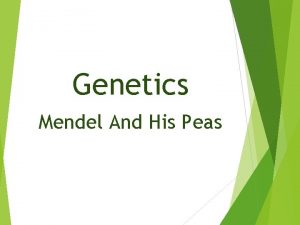Gregor Mendels Peas Gregor Mendels Peas Genetics is



























- Slides: 27

Gregor Mendel’s Peas • Gregor Mendel’s Peas – Genetics is the scientific study of heredity. • Gregor Mendel was an Austrian monk. • Mendel studied garden peas

Gregor Mendel’s Peas –Mendel knew that – the male part of each flower produces pollen, (containing sperm). – the female part of the flower produces egg cells. – Together they make a new plant

Gregor Mendel’s Peas • Pea flowers are self-pollinating. (Pollen can fertilize the flower it was made on) • Self-pollination results in the offspring getting all its DNA from 1 organism.

Gregor Mendel’s Peas • Mendel used True-Breeding Pea plants – Plants that were homozygous for a trait • To prevent Self pollination- Mendel removed either the male or the female parts from each flower.

Gregor Mendel’s Peas • Mendel took a brush and crosspollinated the flowers by hand! • Mendel was able to produce seeds that had two different parents.

Genes and Dominance • Genes and Dominance – A trait is a specific characteristic that varies from one individual to another.

Genes and Dominance • Each original pair of plants is the P (parental) generation. • The offspring are called the F 1, or “first filial, ” generation. • The offspring of crosses between parents with different traits are called hybrids. • The F 1 hybrid plants all had the character of only one of the parents.

Genes and Dominance • Mendel studied seven pea plant traits, each with two contrasting characters. • He crossed plants with each of the seven contrasting characters and studied their offspring.

Genes and Dominance Mendel’s F 1 Crosses on Pea Plants

Genes and Dominance Mendel’s Seven F 1 Crosses on Pea Plants Mendel’s F 1 Crosses on Pea Plants

Genes and Dominance • Mendel's first conclusion was that biological inheritance is determined by factors that are passed from one generation to the next. • We call these factors GENES

Genes and Dominance • Mendel luckily chose traits controlled by a single gene with different forms. • The different forms of a gene are called alleles(ah-le-eels).

GENOTYPE vs PHENOTYPE • GENOTYPE – are the actual DNA coded genes or instructions that make you. • PHENOTYPE – The express or what the genotype looks like in the physical world. For short – What you look like.

Genes and Dominance – The principle of dominance states that some alleles are dominant and others are recessive.

Genes and Dominance • Dominant alleles – Only need one for this form to show in the phenotype Possible Genotype – (DD or Dr) • Recessive – Need two alleles for this one to show in the phenotype Possible Genotype– (rr)

Segregation • Segregation – Mendel crossed the F 1 generation with itself to produce the F 2 (second filial) generation. – The traits controlled by recessive alleles reappeared in one fourth of the F 2 plants.

Segregation • The reappearance of the trait controlled by the recessive allele indicated that at some point the allele for shortness had been separated, or segregated, from the allele for tallness.

Segregation • During the formation of GAMETES (sex cells) – Alleles are separated (segregated) into different resulting daughter cells.

Segregation • Alleles separate during gamete formation.

Using a Punnett Square

What is a PUNNETT SQUARE? • A tool to predict the probability of certain traits in offspring that shows the different ways alleles can combine • A way to show phenotype & genotype • A chart that shows all the possible combinations of alleles that can result when genes are crossed

What is a PUNNETT SQUARE? • Letters stand for dominant and recessive alleles • An uppercase letter stands for a dominant allele • Lowercase letters stand for recessive alleles

Using a PUNNETT SQUARE To set up a Punnett square, draw a large square, and then divide it into 4 equal sections (also squares). It should look something like this:

Using a PUNNETT SQUARE Now you need two parents to mate, ones with a known genotype For example, a red flower (genotype Rr) and a white flower (genotype rr). Rr x rr

Using a PUNNETT SQUARE Place one of the parents on top, and one on the left. You should get a something similar to this:

Using a PUNNETT SQUARE Finally, take each letter in each column and combine it with each letter from each row in the corresponding square. You should now have a picture close to this:

Using a PUNNETT SQUARE • The two-letter combinations are the possible genotypes of offspring • They are: Rr, rr, and rr genotypes • From this it is possible to determine the probability (chance) that a flower will have a red phenotype (2/4 or 50%) or a white phenotype (2/4 or 50%)
 Gregor mendels principles of genetics apply to
Gregor mendels principles of genetics apply to Gregor mendels peas
Gregor mendels peas Gregor mendel plant
Gregor mendel plant Was mendel a monk
Was mendel a monk Chapter 11 biology test
Chapter 11 biology test How did gregor mendel contribute to genetics
How did gregor mendel contribute to genetics Mendel and his peas lesson 1
Mendel and his peas lesson 1 Chapter 12 lesson 2 applying mendels principles
Chapter 12 lesson 2 applying mendels principles Applying mendel's principles
Applying mendel's principles Mendels sps
Mendels sps Mendels law of segregation states that
Mendels law of segregation states that Mendels two laws
Mendels two laws Mendels fabric
Mendels fabric Que muestra
Que muestra Gregor mendel mbti
Gregor mendel mbti Mendels law
Mendels law Mendel's first law
Mendel's first law Section 9-1 review mendel's legacy
Section 9-1 review mendel's legacy Applying mendels principles
Applying mendels principles Mendels law
Mendels law What are mendel's three laws of inheritance
What are mendel's three laws of inheritance Mendel laws
Mendel laws Andalusian chicken incomplete dominance
Andalusian chicken incomplete dominance Applying mendels principles
Applying mendels principles Law of segregation vs law of independent assortment
Law of segregation vs law of independent assortment 11.2 applying mendel's principles
11.2 applying mendel's principles Mendels
Mendels Gregor mendel referat
Gregor mendel referat





